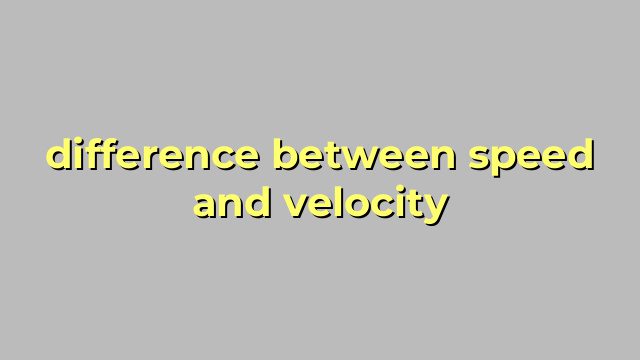The Difference between Speed and Velocity: A Comprehensive Explanation
When it comes to physics and motion, two words that are often used interchangeably are “speed” and “velocity.” However, they are not the same thing, and understanding their differences can be crucial in various fields, such as engineering, sports, and even driving. In this article, we’ll explain the distinction between speed and velocity and why it matters.
What is Speed?
Speed is a scalar quantity that refers to how fast an object is moving. It is defined as the distance traveled by an object in a given amount of time, without any consideration for the direction. The formula for calculating speed is:
Speed = distance/time
For example, if you run 50 meters in 10 seconds, your average speed is 5 meters per second.
One important thing to note about speed is that it can be constant or changing. For instance, if you’re driving a car on a straight road, and you maintain the same speed throughout, then your speed is constant. However, if you’re cycling up a hill, your speed will gradually decrease due to the increase in resistance.
What is Velocity?
Velocity, on the other hand, is a vector quantity that takes into account both the speed and direction of an object. It indicates how fast an object moves in a specific direction. The formula for calculating velocity is:
Velocity = displacement/time
Displacement refers to the difference between the final and initial positions of an object, and it includes both the distance and direction. For example, if a car moves 40 meters north in 5 seconds, and then returns 40 meters south in 5 seconds, its displacement is zero, and its velocity is also zero.
Unlike speed, velocity can never be constant if the direction is changing. That’s because even if an object is moving at the same speed, if it’s changing direction, then its velocity is also changing.
Why is the Difference Important?
Knowing the difference between speed and velocity is critical in several fields, particularly in engineering and sports. For example, in engineering, it’s important to consider an object’s velocity when designing machines that need to accelerate, decelerate or change direction. In sports, velocity can determine an athlete’s performance, particularly in sports where the direction of the movement is crucial, such as running and swimming.
Another instance where this difference matters is driving. Road signs typically indicate the speed limit; however, what’s more important for safety is the velocity. A car that’s traveling at the speed limit on a straight road is less of a hazard than one that’s going the same speed but swerving on a winding road.
Conclusion
To sum up, speed and velocity may seem similar, but they are different concepts. Speed is the rate of change of distance, while velocity is the rate of change of displacement. While speed is a scalar quantity that only considers magnitude, velocity is a vector quantity that takes direction into account. Understanding this distinction is essential in several fields and can help make informed decisions based on the specific motion and direction of objects.
Table difference between speed and velocity
| Aspect | Speed | Velocity |
|---|---|---|
| Definition | The distance covered per unit time where direction is not considered | The change in position per unit time in a specific direction |
| Formula | Speed = Distance / Time | Velocity = Displacement / Time |
| Measurement | Scalar quantity (only magnitude is considered) | Vector quantity (magnitude and direction are considered) |
| Unit | Meters per second (m/s), kilometers per hour (km/h), miles per hour (mph), etc | Meters per second (m/s), kilometers per hour (km/h), miles per hour (mph), etc |
| Example | A car traveling at 60 mph | A car traveling at 60 mph to the north |
| Importance | Helps to understand how fast an object is moving without considering its direction | Helps to understand the speed and direction of an object which is an important aspect in many physical problems |


